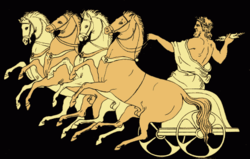|
Greek city of Abbaitis in PHRYGIA
Bronze 19mm (8.44 grams) Struck circa 150 B.C.
Reference: Sear 5096; B.M.C. 25.1,4-6
Laureate head of Zeus right.
MYΣΩN / ΑΒΒΑΙΤΩΝ above and below winged thunderbolt, monogram beneath; all
within oak wreath.
This district of western Phrygia was occupied by a people of
Mysian origin. Their coins were probably struck at the city of Ankyra..
You are bidding on the exact item pictured,
provided with a Certificate of Authenticity and Lifetime Guarantee of
Authenticity.
In the
ancient Greek
religion
, Zeus
zews
zooss
;
Ancient Greek
: Ζεύς;
Modern
Greek
: Δίας, Dias) was the “Father of Gods and men” (πατὴρ
ἀνδρῶν τε θεῶν τε)
who ruled the Olympians of
Mount
Olympus
as a father ruled the family. He was the
god of sky
and
thunder
in
Greek mythology
. His
Roman
counterpart is
Jupiter
and
Etruscan
counterpart is
Tinia
.![The Jupiter de Smyrne, discovered in Smyrna in 1680[1]](https://upload.wikimedia.org/wikipedia/commons/thumb/c/c8/Jupiter_Smyrna_Louvre_Ma13.jpg/200px-Jupiter_Smyrna_Louvre_Ma13.jpg)
Zeus was the child of
Cronus
and
Rhea
, and the youngest of his siblings. In most
traditions he was married to
Hera, although, at the oracle of
Dodona
, his consort was
Dione
: according to the
Iliad
, he is the father of
Aphrodite
by Dione.
He is known for his erotic escapades. These resulted in many godly and heroic
offspring, including
Athena
,
Apollo
and
Artemis
,
Hermes
,
Persephone
(by
Demeter
),
Dionysus
,
Perseus
,
Heracles
,
Helen of Troy
,
Minos
, and the
Muses (by
Mnemosyne
); by Hera, he is usually said to have
fathered Ares
,
Hebe
and
Hephaestus
.
As
Walter Burkert
points out in his book, Greek
Religion, “Even the gods who are not his natural children address him as
Father, and all the gods rise in his presence.”
For the Greeks, he was the
King of the Gods
, who oversaw the universe. As
Pausanias
observed, “That Zeus is king in
heaven is a saying common to all men”.
In Hesiod’s Theogony
Zeus assigns the various gods
their roles. In the
Homeric Hymns
he is referred to as the
chieftain of the gods.
His symbols are the
thunderbolt
,
eagle
,
bull
, and
oak.
In addition to his Indo-European inheritance, the classical “cloud-gatherer”
also derives certain iconographic traits from the cultures of the
Ancient Near East
, such as the
scepter
. Zeus is frequently depicted by Greek
artists in one of two poses: standing, striding forward, with a thunderbolt
leveled in his raised right hand, or seated in majesty.
Etymology

The Chariot of Zeus, from an 1879 Stories from the Greek
Tragedians by Alfred Church
In antiquity,
Phrygia (Greek:
Φρυγία) was a kingdom in the

west
central part of Anatolia
, in what is now modern-day
Turkey
. The
Phrygians (Phruges or Phryges) initially lived in the southern
Balkans
;
according to Herodotus
, under the name of
Bryges
(Briges),
changing it to Phruges after their final migration to Anatolia, via the
Hellespont
.
During the flourishing of the city-state of
Troy, a part of the
Bryges emigrated to
Anatolia
as
Trojan allies or under the protection of Troy.[
neededcitation] The Trojan language did not survive; consequently, its
exact relationship to the
Phrygian language
and the affinity of Phrygian society to that of Troy
remain open questions. Similarly, the date of migration and the relationship of
the Phrygians to the
Hittite empire
are unknown. They are, however, often considered part of a “Thraco-Phrygian”
group. A conventional date of c. 1200 BC often is used, at the very end of the
empire. It is certain that Phrygia was constituted on Hittite land, and yet not
at the very center of Hittite power in the big bend of the
Halys River
, where
Ankara
now is.
Subsequently the state of Phrygia arose in the
8th
century BC
with its capital at
Gordium
.
During this period, the Phrygians extended eastward and encroached upon the
kingdom of Urartu
,
the descendants of the
Hurrians
, a
former rival of the Hittites.
Meanwhile the Phrygian Kingdom was overwhelmed by Iranian
Cimmerian
invaders c. 690 BC, then briefly conquered by its neighbor
Lydia
, before it
passed successively into the
Persian Empire
of
Cyrus
and the empire
of
Alexander
and his
successors
,
was taken by the
Attalids
of Pergamon
, and eventually became part of the
Roman
Empire
. The last mentions of the language date to the 5th century AD and it
was likely extinct by the 7th century AD.[1]
When the Romans entered its capital Sardis in 133 BC, Lydia, as the other
western parts of the Attalid legacy, became part of the
province of Asia
, a very rich
Roman province
, worthy of a governor of the high rank of
proconsul
.
The whole west of Asia Minor had
Jewish
colonies very early, and Christianity was also soon present there.
Acts of the Apostles
16:14-15 mentions the baptism of a merchant woman
called “Lydia” who came from
Thyatira
,
in what had once been the satrapy of Lydia. Christianity spread rapidly in the
3rd century AD, centered on the nearby Exarchate of Ephesus.
|




![The Jupiter de Smyrne, discovered in Smyrna in 1680[1]](https://upload.wikimedia.org/wikipedia/commons/thumb/c/c8/Jupiter_Smyrna_Louvre_Ma13.jpg/200px-Jupiter_Smyrna_Louvre_Ma13.jpg)





